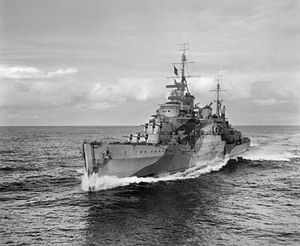Our website is made possible by displaying online advertisements to our visitors.
Please consider supporting us by disabling your ad blocker.
HMS Liverpool (C11)
 Liverpool underway, 28 February 1942
| |
| History | |
|---|---|
| Name | Liverpool |
| Namesake | Liverpool |
| Ordered | 1935 |
| Builder | Fairfield Shipbuilding and Engineering Company, Govan |
| Laid down | 17 February 1936 |
| Launched | 24 March 1937 |
| Commissioned | 2 November 1938 |
| Decommissioned | 1952 |
| Identification | Pennant number: C11 |
| Honours and awards |
|
| Fate | Sold for scrap, July 1958 |
| General characteristics (as built) | |
| Class and type | Town-class light cruiser |
| Displacement | |
| Length | 591 ft (180 m) overall |
| Beam | 64 ft 10 in (19.76 m) |
| Draught | 20 ft 7 in (6.27 m) |
| Installed power |
|
| Propulsion | 4 shafts; 4 geared steam turbine sets |
| Speed | 32.3 knots (59.8 km/h; 37.2 mph) |
| Range | 6,000 nmi (11,000 km; 6,900 mi) at 14 knots (26 km/h; 16 mph) |
| Complement | 800–850 |
| Armament |
|
| Armour |
|
| Aircraft carried | Three Supermarine Walrus; one catapult |
HMS Liverpool, named after the port city of Liverpool in north-west England, was a Town-class cruiser of the Royal Navy in service from 1938 to 1952.
During the Second World War, Liverpool gained four battle honours and was seriously damaged in two attacks by Italian torpedo bombers. The cruiser operated variously with the naval stations in the East Indies and China and with the Mediterranean and Home fleets. While assigned as flagship to the China Station in January 1940, the cruiser instigated a diplomatic incident with Japan when she intercepted the liner Asama Maru off the coast of Japan. Liverpool took part in the battles of the Espero Convoy and Calabria, the Arctic Convoys, and Operation Harpoon during the Malta Convoys. On 14 June 1942, during Operation Harpoon, Liverpool suffered an air attack and had to undergo repairs and refitting at Rosyth, Scotland for the remainder of the war.
Liverpool returned to service in 1945 and was assigned as flagship to the Mediterranean Fleet. In the early 1950s, the cruiser harboured in Port Said to support the British Administration of the Suez Canal Zone, when Egyptian guerrillas campaigned against it. The cruiser was decommissioned in 1952 at a time when the Royal Navy was rapidly contracting in strength. Liverpool was broken up in 1958, at Rosyth.
- ^ Morris (1987), p. 208
Previous Page Next Page


